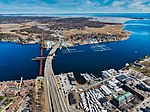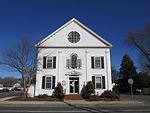Newburyport Harbor Light
1788 establishments in MassachusettsBuildings and structures in Newburyport, MassachusettsEssex County, Massachusetts Registered Historic Place stubsLighthouses completed in 1788Lighthouses completed in 1898 ... and 4 more
Lighthouses in Essex County, MassachusettsLighthouses on the National Register of Historic Places in MassachusettsNational Register of Historic Places in Essex County, MassachusettsUnited States lighthouse stubs

The Newburyport Harbor Light, also known as Plum Island Light, built in 1788, is a historic lighthouse on Northern Boulevard in Newburyport, Massachusetts.The original 4th order Fresnel lens is still in use, one of only five original glass Fresnel lenses still in use in Massachusetts.The light is now owned by the City of Newburyport and is leased to the Friends of Plum Island Light.It was added to the National Register of Historic Places as Newburyport Harbor Light on June 15, 1987, reference number 87001485.
Excerpt from the Wikipedia article Newburyport Harbor Light (License: CC BY-SA 3.0, Authors, Images).Newburyport Harbor Light
Point Road, Newburyport Plum Island
Geographical coordinates (GPS) Address External links Nearby Places Show on map
Geographical coordinates (GPS)
| Latitude | Longitude |
|---|---|
| N 42.815230555556 ° | E -70.818938888889 ° |
Address
Newburyport Harbor (Plum Island) Light (Newburyport Light)
Point Road
01951 Newburyport, Plum Island
Massachusetts, United States
Open on Google Maps








